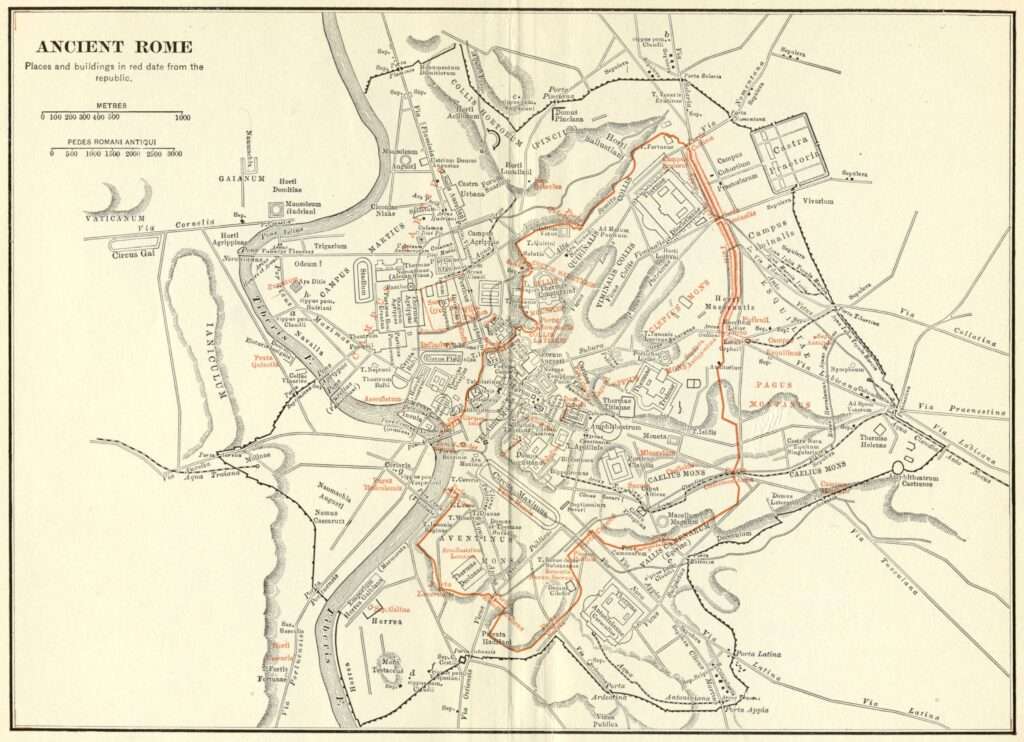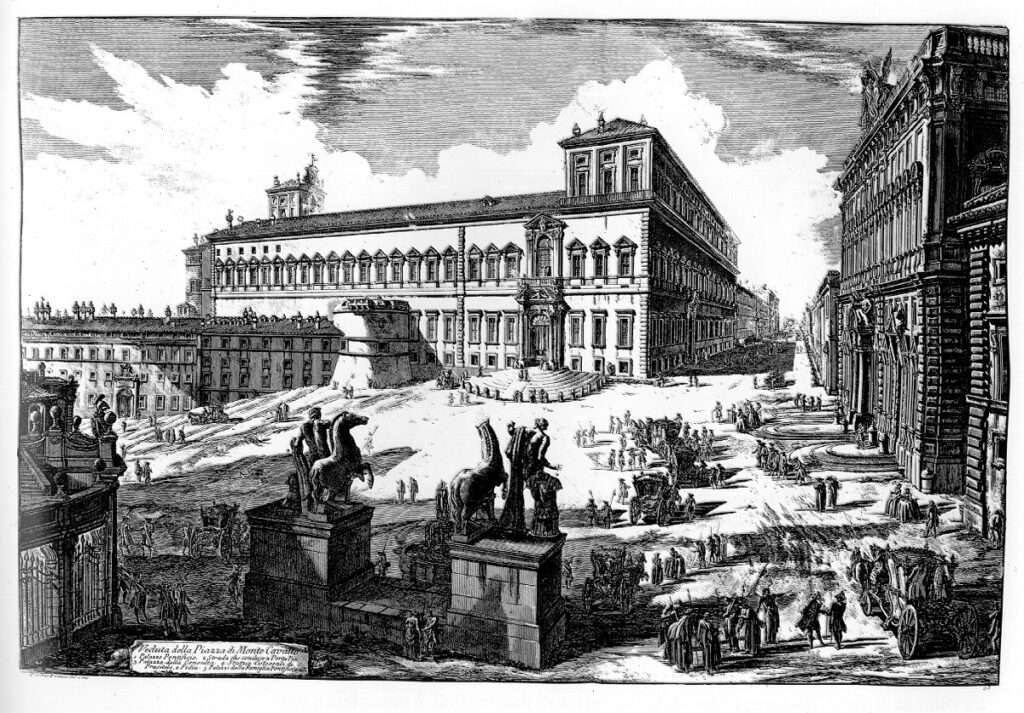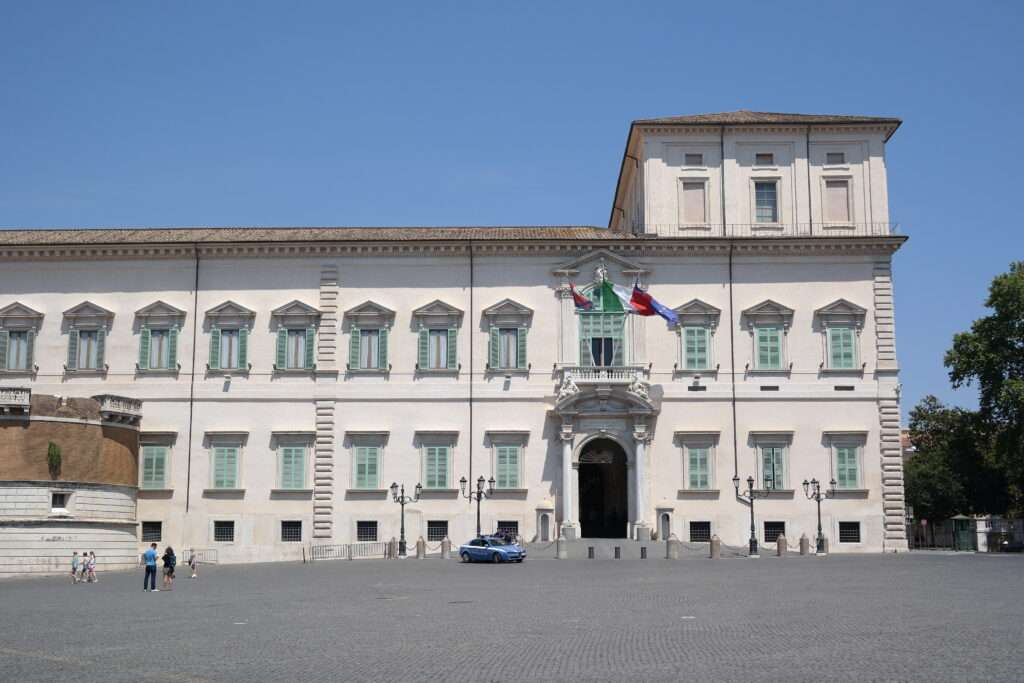The Quirinal Hill (Quirinalis Collis or Quirinale) is the northernmost of the Seven Hills of Ancient Rome.
Location
It is located in the northeast of Rome. This hill was long and typically considered to stretch the Servian Agger and Porta Collina in the northeast to the very center of Rome in the southwest.
To the east, one would spot the Castra Praetoria (barracks of the Praetorian Guard), while the Via Nomentana and Via Salaria were two major Roman roads that were also found here. The Via Nomentana starts at the Porta Collina in the Servian Wall, passes through the Porta Nomentana in the later Aurelian Wall, and then exits the city. The Via Salaria forks off the Via Nomentana and passes through the Porta Salaria a bit further north. Immediately east of the hill, we would find the Viminal Hill (Viminalis Collis).
North of the hill are the Gardens of Sallust (Horti Sallustiani). On the other side of the gardens is the Pincian Hill – a hill in its own right, but not one of the original Seven Hills of Rome. We could find the Domus Pinciana, Horti Lucullani (Gardens of Lucullus), and the Porta Pinciana on this hill.

Northwest was the Campus Martius (Field of Mars) and would have spotted structures such as the Castra Urbana (barracks of the Urban Cohorts), Forum Suarium, Campus Agrippae, Aqua Virgo, Arch of Hadrian and the Mausoleum of Augustus, among other things.
The Campus Martius was also located to the west of the Quirinal Hill. In this part of the Campus Martius, we would see structures such as the Arch of Claudius, the Column of Marcus Aurelius, the Thermae Agrippae (Baths of Agrippa), Thermae Neroninae (Baths of Nero), the Pantheon and the Circus Flaminius. Much closer to the hill itself was Trajan’s Forum, which butted up against the southwestern slope.
To the southwest, we would spot Trajan’s Forum, while on the other side of that is the Capitoline Hill. In between Trajan’s Forum and the Capitoline Hill was the Porta Fontinalis, which was part of the Servian Wall.
South of the hill is the center of Rome itself. Here, we would see the Forum Augusti (Forum of Augustus), Forum Caesaris (Forum of Caesar), Temple of Nerva, Basilica Aemilia, Basilica Julia, the Temple of Castor and Pollux, Basilica of Constantine and the Temple of Venus and Roma. On the other side of that is the Palatine Hill, which has various palaces and emperor residences.
Southeast of the hill, one would see the Colosseum and the Colossus of Nero. We would also see the Esquiline Hill, which featured the Baths of Trajan and the Baths of Titus on its Oppian Hill ’spur’. We could also spot the Porticus of Livia on the western slope of the Esquiline Hill.
On the Quirinal Hill itself, historically, it was pretty busy as it was such a large hill.
There were two bath complexes: the Baths of Diocletian in the northeast and the Baths of Constantine in the southwest.
There were several temples on the Quirinal Hill. The Temple of Fortuna was located in the northeast near the Porta Collina. The Capitolium Vetus (an archaic temple dedicated to the Capitoline Triad) was located near the center of the hill, as was the Temple of Quirinus (built in the early third century BC). There was also a Temple of Salus, Temple of Serapis, and Aedes (Temple) of Semo Sancus. These were located in the southwest of the Quirinal Hill.
Aside from the Porta Collina on the northeastern side of the hill, there were three other gates on the Quirinal Hill. These gates were part of the Servian Wall and were located on the hill’s western side.
The northernmost gate was the Porta Quirinalis, followed by the Porta Salutaris to the southwest and then Porta Sanqualis further south.
History
The history of Quirinal Hill goes back to Rome’s formative years.
There is conjecture about how the Quirinal Hill got its name, with theories ranging from being named after a temple or sanctuary to being named after citizens of a Sabine town.

by Giovanni Battista Piranesi (1750) – Public domain
Marcus Terentius Varro notes these possibilities in his work, On the Latin Language, V.LI:
“The Quirinal Hill was so named because there was the sanctuary of Quirinus. Others say that it is derived from the Quirites, who came with Tatius from Cures to the vicinity of Rome because there they established their camp.”
(It must be noted that the Tatius mentioned here is the Sabine king, Titus Tatius.)
Livy is in concurrence with the latter theory when writing about Romulus and Titus Tatius sharing power after a truce was struck between the two in his work, The History of Rome, Book I, XIII.V:
“They shared the sovereignty, but all authority was transferred to Rome. In this way, the population was doubled, and that some concession might, after all, be granted the Sabines, the citizens were named Quirites, from the town of Cures.”
Livy also points out that Servius Tullius added the Quirinal Hill to Rome, thus enlarging the city. Book I, XLIV.III:
“To contain that population, it was obvious that the city would have to be enlarged. He added to it the two hills —the Quirinal and the Viminal —and then made a further addition by including the Esquiline, and to give it more importance, he lived there himself. He surrounded the city with a mound and moats and wall; in this way, he extended the ‘pomerium.’”
Dionysius of Halicarnassus notes that Romulus and Tatius had enlarged the city to include the Quirinal and Caelian Hills. He writes in his work, Roman Antiquities, Book II, L.I:
“Romulus and Tatius immediately enlarged the city by adding to it two other hills, the Quirinal, as it is called, and the Caelian; and separating their habitations, each of them had his particular place of residence. Romulus occupied the Palatine and Caelian hills, the latter being next to the Palatine, and Tatius the Capitoline hill, which he had seized in the beginning, and the Quirinal.”
The sources seem to contradict each other, but there appears to be an important distinction. While Romulus and Tatius occupied these hills, Servius Tullius extended the sacred boundary (the ‘pomerium’) to include them and also included them within the city’s walls (the Servian Wall).
According to Plutarch, Rome’s second King, Numa Pompilius, occasionally resided on the Quirinal Hill. However, no evidence of the house has been found. In his work, The Parallel Lives – The Life of Numa, XIV.I, he writes:
“After Numa had thus established and regulated the priestly orders, he built, near the temple of Vesta, the so‑called Regia, or royal house. Here, he passed most of his time performing sacred functions, or teaching the priests, or engaged in the quiet contemplation of divine things. He also had another house on the Quirinal hill, the site of which is still pointed out.”
During the Sack of Rome in 390 BC by the Gauls, Gallic chieftain Brennus entered the city via the Porta Collina on the Quirinal Hill.
As Plutarch notes in The Parallel Lives – The Life of Camillus, Brennus encountered little resistance, such was the weakness of the Roman army at the time. XXII.I:
“On the third day after the battle, Brennus came up to the city with his army. Finding its gates open and its walls without defenders, at first, he feared a treacherous ambush, being unable to believe that the Romans were in such utter despair. But when he realized the truth, he marched in by the Colline gate and took Rome.”
In later history, churches and palaces were built on the hill throughout the Middle Ages, while modern urbanization transformed the hill, giving it a vastly different look to its historical past.
What is now on the Quirinal Hill?
The most notable structure on the Quirinal Hill is the Quirinal Palace, which is the official residence of the President of Italy. It was completed in 1583 and was formerly a residence of Popes (with thirty residing there) and four kings who were in power before the modern republic.

Besides the Quirinal Palace, a few other palaces are located on the hill. These include Palazzo Barberini (completed 1633), Palazzo Baracchini (1883), Palazzo Colonna (the oldest part of the palace dates to the thirteenth century), Palazzo Pallavincini-Rospigliosi (1616), and Palazzo della Consulta (1737) among others.
A few churches are located on the hill, including Sant’Andrea al Quirinale (completed 1670), San Carlo alle Quattro Fontane (1641), and San Silvestro al Quirinale (a church on this site was mentioned in the eleventh century but has undergone several changes over the centuries).
In the Piazza Quirinal, there are also two colossal statues, known as the Horse Tamers. These statues are generally identified as the Dioscuri (Castor and Pollux).
Sources:
On the Latin Language – Varro (W. Heinemann)
The History of Rome – Livy (Perseus Digital Library)
Roman Antiquities – Dionysius of Halicarnassus (Thayer)
The Parallel Lives – Plutarch (Thayer)

